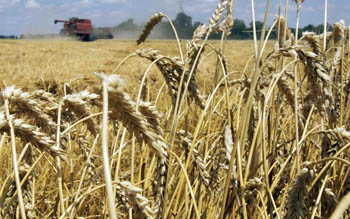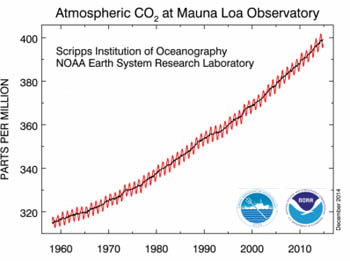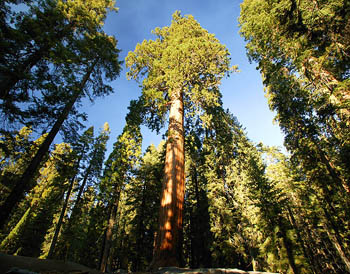Environment
 |
 |
 |
 |
 |
 |
 |
Record CO2 & Record-Breaking Crops
Disprove Global Warning
Eight years after the United Nations’ Intergovernmental Panel on Climate Change (IPCC) warned of mass starvation from global warming caused by high levels of atmospheric carbon dioxide (CO2), emissions of the greenhouse gas are at record levels. But so is worldwide crop production.
The IPCC’s Fourth Assessment Report, which was edited by then-chairman Dr. Rajendra Pachauri and released in 2007, predicted with “virtual certainty” that crop yields would plummet in some areas unless industrialized nations immediately adopted stricter limits on CO2, which the IPCC said was causing “dangerous anthropogenic interference with the climate system.”
 “By 2020, in some countries, yields from rain-fed agriculture could be reduced by up to 50%,” the report predicted. But last year, even a record level of atmospheric CO2 did not keep farmers from reaping record-breaking harvests worldwide, including a record opium crop in Afghanistan.
“By 2020, in some countries, yields from rain-fed agriculture could be reduced by up to 50%,” the report predicted. But last year, even a record level of atmospheric CO2 did not keep farmers from reaping record-breaking harvests worldwide, including a record opium crop in Afghanistan.
The monthly CO2 average in November 2014 was 397.13 parts per million as measured at the Mauna Loa Observatory in Hawaii, which maintains “the longest record of direct measurements of CO2 in the atmosphere,” according to the National Oceanic and Atmospheric Administration (NOAA).
The level of atmospheric CO2 was 315.97 ppm in 1959, when it was first measured, and is now about 40 % higher than it was during the pre-industrial era.
However, according to a report also released in November by the U.N.’s Food and Agriculture Organization, “world cereal production in 2014 is forecast at a new record of 2,532 million tones … 7 million tonnes (0.3 %) above last year’s peak.” That includes a record level of wheat production worldwide, according to the U.S. Department of Agriculture.
Atmospheric CO2 increased 14 % between 1982 and 2010, coinciding with a “5 to 10% increase in green foliage cover in warm, arid environments,” according to a June 2013 study published in the peer-reviewed journal, Geophysical Research Letters. The study stated that the CO2 “fertilization effect is now a significant land surface process” and has created “a greening of the globe over recent decades.”
That greening effect includes a growth spurt among redwoods and giant sequoias in California.
 “Since the 1970s we’ve seen an increase in wood production and that’s making these trees get even bigger than they were growing earlier in the 20th century,” said Emily Burns, director of science at Save the Redwoods League, who added that the accelerated growth winds up naturally sequestering the additional carbon.
“Since the 1970s we’ve seen an increase in wood production and that’s making these trees get even bigger than they were growing earlier in the 20th century,” said Emily Burns, director of science at Save the Redwoods League, who added that the accelerated growth winds up naturally sequestering the additional carbon.
That’s not a coincidence, says Dr. James Taylor, senior fellow for environmental policy at the Heartland Institute. “For virtually every crop that’s grown in the United States and globally, we see record crop production on just about a yearly basis,” he said. This is happening at the same time that CO2 levels have been rising because plants use the greenhouse gas to make food in a process called photosynthesis.
“Claims that global warming and more atmospheric carbon dioxide are harming crop production are simply preposterous, and they’re proven preposterous by the real-world, objective data,” Taylor told CNSNews.com.
“We know that in recent decades, we’ve seen an actual tripling of production of the most important staple crops: corn, wheat, and rice. There’s been a record production of wheat in the past year in the United States, in India, in much of Africa, and throughout the world where the wheat harvest is important."
Instead of diminishing crop yields, high levels of CO2 actually help to increase them, he said.
“As we add more carbon dioxide to the atmosphere, it can be expected that that’s going to benefit crop production because carbon dioxide is aerial plant fertilizer. That’s what people pump into greenhouses to facilitate plant growth,” Taylor told CNSNews.com.
 “Just as people have demonstrated in greenhouses, where plants that are growing in greenhouses - with more atmospheric carbon dioxide there, those plants grow more rapidly and are more productive - such has been the case also in the natural environment when we’ve had more atmospheric carbon dioxide,” Taylor explained.
“Just as people have demonstrated in greenhouses, where plants that are growing in greenhouses - with more atmospheric carbon dioxide there, those plants grow more rapidly and are more productive - such has been the case also in the natural environment when we’ve had more atmospheric carbon dioxide,” Taylor explained.
“So whether it be redwoods in California, tropical rain forests around the globe, [or] boreal forests in the polar region, we see that as carbon dioxide has increased in the atmosphere, there is greater growth for these trees, and not just trees, but all plant life. This is something to be welcomed.”
“Any time that we have more atmospheric carbon dioxide, we’re going to see plant life benefit spectacularly,” he added.
CNSNews.com asked Taylor whether the link between high levels of CO2 and record crop yields worldwide was discussed at the UN’s climate change conference in Lima last month.
“No, it never came up,” he replied. “To the extent that crop production was discussed at the United Nation meetings, it was in the context of claiming that global warming is wreaking havoc on crops. And that’s simply not the case.
“What you have to understand is that this is the United Nations’ Intergovernmental Panel on Climate Change. These are government bodies. These are government appointees. Some of them are scientists, but many of them are not. And even those who are scientists tend to be scientists who work for environmental activist groups such as The Sierra Club, the Environmental Defense Fund, Greenpeace, World Wildlife Fund, etc. They have an agenda to push. It’s very little objective science. It’s 99 % politics from an environmental activist agenda.
”And unfortunately in that environment, the facts simply don’t come out if people aren’t doing their own research. If we’re just listening and reading the UN press releases, we’re going to believe that a world exists that is exactly opposite from what the real world really is.”
Despite the "greening of the globe," the IPCC and environmental groups are still pushing for steep worldwide reductions of carbon dioxide. Last month, White House science adviser John Holdren said he’s like to get CO2 emissions “close to zero by 2100.”
“To preserve a livable planet, scientists tell us we must reduce the amount of CO2 in the atmosphere from its current level of 400 parts per million to below 350 ppm,” according to 350.org, an international environmental group.
CNSNews.com asked Jamie Henn, director of strategy and communications at 350.org, to explain his group’s desire to drastically reduce CO2 emissions in light of this year's record-breaking harvests worldwide.
“The disastrous aspects of climate change are well-documented by scientists, including those at the IPCC. That’s the reason why people are very concerned about it. No doubt climate change has some positive impacts on the whole, but it’s disastrous in the long run,” Henn replied.
Barbara Hollingsworth is a columnist for CNSNews.com
where this articlewas first published on January 6, 2015.

The IPCC’s Fourth Assessment Report, which was edited by then-chairman Dr. Rajendra Pachauri and released in 2007, predicted with “virtual certainty” that crop yields would plummet in some areas unless industrialized nations immediately adopted stricter limits on CO2, which the IPCC said was causing “dangerous anthropogenic interference with the climate system.”

Record crops around the world
The monthly CO2 average in November 2014 was 397.13 parts per million as measured at the Mauna Loa Observatory in Hawaii, which maintains “the longest record of direct measurements of CO2 in the atmosphere,” according to the National Oceanic and Atmospheric Administration (NOAA).
The level of atmospheric CO2 was 315.97 ppm in 1959, when it was first measured, and is now about 40 % higher than it was during the pre-industrial era.
However, according to a report also released in November by the U.N.’s Food and Agriculture Organization, “world cereal production in 2014 is forecast at a new record of 2,532 million tones … 7 million tonnes (0.3 %) above last year’s peak.” That includes a record level of wheat production worldwide, according to the U.S. Department of Agriculture.
Atmospheric CO2 increased 14 % between 1982 and 2010, coinciding with a “5 to 10% increase in green foliage cover in warm, arid environments,” according to a June 2013 study published in the peer-reviewed journal, Geophysical Research Letters. The study stated that the CO2 “fertilization effect is now a significant land surface process” and has created “a greening of the globe over recent decades.”
That greening effect includes a growth spurt among redwoods and giant sequoias in California.

Graph showing atmospheric CO2 levels going up
That’s not a coincidence, says Dr. James Taylor, senior fellow for environmental policy at the Heartland Institute. “For virtually every crop that’s grown in the United States and globally, we see record crop production on just about a yearly basis,” he said. This is happening at the same time that CO2 levels have been rising because plants use the greenhouse gas to make food in a process called photosynthesis.
“Claims that global warming and more atmospheric carbon dioxide are harming crop production are simply preposterous, and they’re proven preposterous by the real-world, objective data,” Taylor told CNSNews.com.
“We know that in recent decades, we’ve seen an actual tripling of production of the most important staple crops: corn, wheat, and rice. There’s been a record production of wheat in the past year in the United States, in India, in much of Africa, and throughout the world where the wheat harvest is important."
Instead of diminishing crop yields, high levels of CO2 actually help to increase them, he said.
“As we add more carbon dioxide to the atmosphere, it can be expected that that’s going to benefit crop production because carbon dioxide is aerial plant fertilizer. That’s what people pump into greenhouses to facilitate plant growth,” Taylor told CNSNews.com.

A growth spurt for sequoias in California
“So whether it be redwoods in California, tropical rain forests around the globe, [or] boreal forests in the polar region, we see that as carbon dioxide has increased in the atmosphere, there is greater growth for these trees, and not just trees, but all plant life. This is something to be welcomed.”
“Any time that we have more atmospheric carbon dioxide, we’re going to see plant life benefit spectacularly,” he added.
CNSNews.com asked Taylor whether the link between high levels of CO2 and record crop yields worldwide was discussed at the UN’s climate change conference in Lima last month.
“No, it never came up,” he replied. “To the extent that crop production was discussed at the United Nation meetings, it was in the context of claiming that global warming is wreaking havoc on crops. And that’s simply not the case.
“What you have to understand is that this is the United Nations’ Intergovernmental Panel on Climate Change. These are government bodies. These are government appointees. Some of them are scientists, but many of them are not. And even those who are scientists tend to be scientists who work for environmental activist groups such as The Sierra Club, the Environmental Defense Fund, Greenpeace, World Wildlife Fund, etc. They have an agenda to push. It’s very little objective science. It’s 99 % politics from an environmental activist agenda.
”And unfortunately in that environment, the facts simply don’t come out if people aren’t doing their own research. If we’re just listening and reading the UN press releases, we’re going to believe that a world exists that is exactly opposite from what the real world really is.”
Despite the "greening of the globe," the IPCC and environmental groups are still pushing for steep worldwide reductions of carbon dioxide. Last month, White House science adviser John Holdren said he’s like to get CO2 emissions “close to zero by 2100.”
“To preserve a livable planet, scientists tell us we must reduce the amount of CO2 in the atmosphere from its current level of 400 parts per million to below 350 ppm,” according to 350.org, an international environmental group.
CNSNews.com asked Jamie Henn, director of strategy and communications at 350.org, to explain his group’s desire to drastically reduce CO2 emissions in light of this year's record-breaking harvests worldwide.
“The disastrous aspects of climate change are well-documented by scientists, including those at the IPCC. That’s the reason why people are very concerned about it. No doubt climate change has some positive impacts on the whole, but it’s disastrous in the long run,” Henn replied.
where this articlewas first published on January 6, 2015.

Posted January 16, 2015
______________________
______________________











